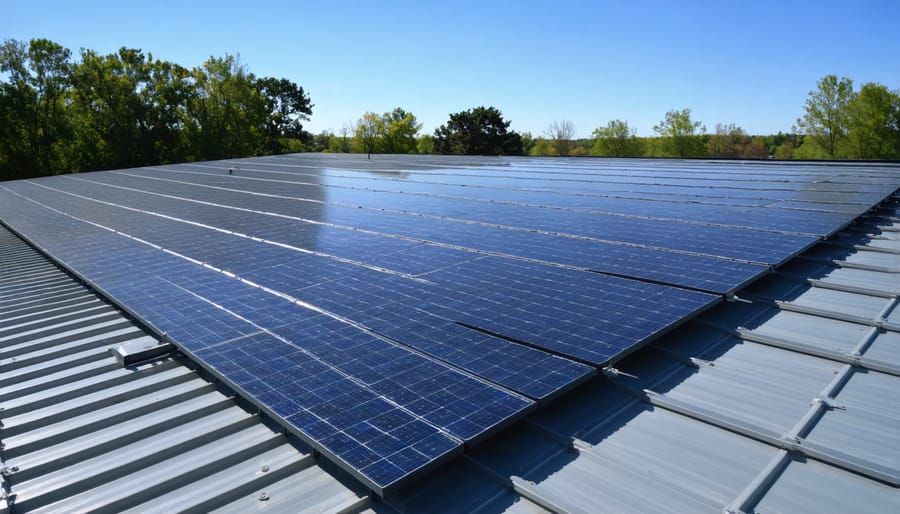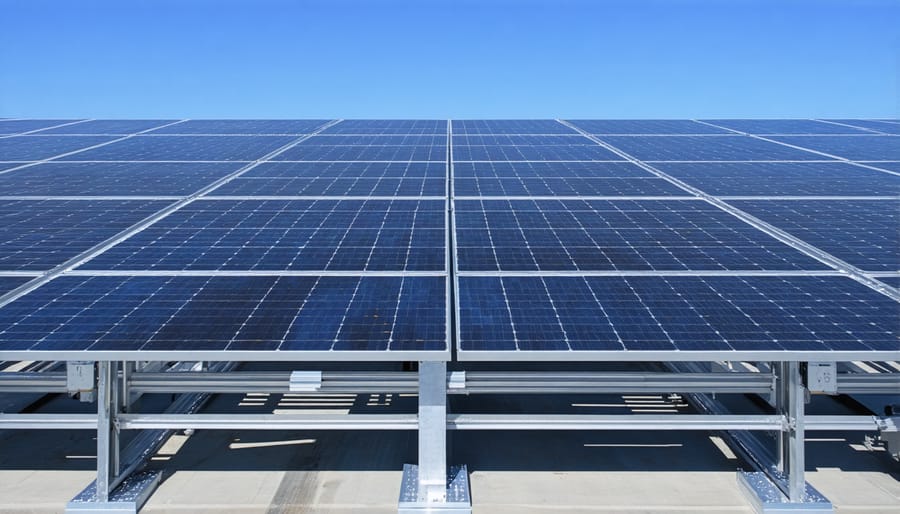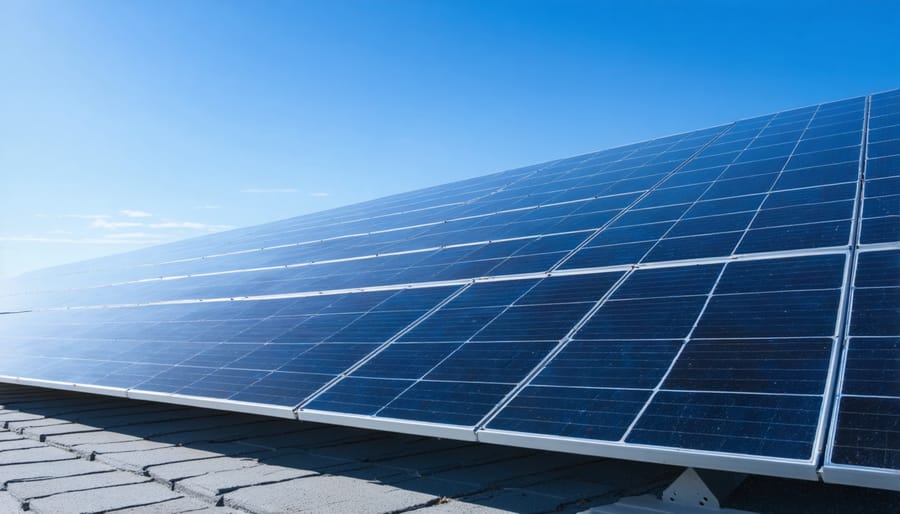Leverage the federal Investment Tax Credit (ITC) to reduce your solar installation costs by 30% through 2032—a direct dollar-for-dollar reduction against your tax liability that transforms a $500,000 commercial solar project into $350,000 in net investment. Accelerate depreciation through the Modified Accelerated Cost Recovery System (MACRS), allowing your business to depreciate 85% of the system’s value over five years and generate substantial additional tax savings that dramatically improve first-year cash flow.
Calculate your combined federal incentive value by adding ITC savings to MACRS depreciation benefits—together, these mechanisms can reduce effective system costs by 50% or more for eligible commercial entities. Understanding how these government solar incentives stack creates a compelling financial case that shortens payback periods from 8-10 years to 4-6 years in most commercial applications.
Document your project timeline carefully, as ITC rates step down after 2032, and ensure your tax appetite can absorb available credits—or explore partnership structures that monetize these benefits if your organization lacks sufficient tax liability. The current federal incentive landscape represents a limited-window opportunity where strategic timing and proper structuring can deliver six-figure savings on commercial-scale installations, making solar adoption not just environmentally responsible but financially advantageous for forward-thinking organizations seeking energy cost predictability and operational resilience.
The Investment Tax Credit (ITC): Your Primary Federal Incentive

How the ITC Works for Commercial Properties
The Investment Tax Credit operates as a dollar-for-dollar reduction in federal tax liability, making it one of the most valuable incentives for commercial solar investments. Currently set at 30% through 2032, the credit applies to the total cost basis of your solar energy system, providing immediate financial benefit in the tax year when the system is placed in service.
**Qualified Expenses Under the ITC**
The ITC covers a comprehensive range of costs associated with solar installation. Eligible expenses include solar panels, inverters, mounting equipment, balance-of-system components, energy storage systems (when charged exclusively by solar), and labor costs for installation. Additionally, development expenses such as permitting fees, engineering studies, and site preparation directly related to the solar system qualify for the credit.
**Claiming the Credit**
Business owners claim the ITC by filing IRS Form 3468 with their federal tax return for the year the system begins operating. The credit directly reduces your tax liability rather than serving as a deduction from taxable income. If the credit exceeds your current year tax liability, you can carry the excess credit back one year or forward up to 20 years, ensuring you capture the full value.
For projects beginning construction in a given year, the applicable ITC rate is locked in even if installation completes in subsequent years, providing planning certainty for multi-phase developments.
Recent Legislative Changes and Timeline
The landscape of federal solar tax incentives underwent significant transformation with the passage of the Inflation Reduction Act (IRA) in August 2022, establishing the most favorable environment for commercial solar investment in over a decade. This landmark legislation extended and enhanced the Investment Tax Credit (ITC), providing unprecedented long-term certainty for solar project planning and financial modeling.
Under the current framework, qualifying commercial solar installations are eligible for a base ITC of 30% of total project costs through December 31, 2032. This represents a substantial increase from the previous trajectory, which had scheduled the credit to decrease to 10% for commercial properties. The extension applies to solar photovoltaic systems, solar water heating equipment, and other qualifying solar technologies placed in service during this period.
For projects meeting specific domestic content and prevailing wage requirements introduced by the IRA, facility managers can access enhanced credit rates reaching up to 50% through bonus provisions. The domestic content bonus adds an additional 10% for projects utilizing qualifying American-made components, while projects in designated energy communities or low-income areas may qualify for further advancements.
The phase-down timeline establishes clear benchmarks for strategic planning. Projects commencing construction before January 1, 2033, lock in the full 30% credit rate, even if completed in subsequent years. Beginning in 2033, the credit reduces to 26% for systems placed in service that calendar year, followed by 22% in 2034. After 2034, commercial solar installations maintain a permanent 10% baseline credit, ensuring ongoing federal support for renewable energy adoption.
Business owners should note that the “commence construction” provision offers flexibility in project timing, as beginning physical work or meeting the 5% safe harbor expenditure threshold secures the applicable credit percentage for projects completed within continuity guidelines.
Modified Accelerated Cost Recovery System (MACRS) Depreciation

Combining MACRS with the ITC for Maximum Savings
Maximizing your solar investment requires understanding how to strategically combine the Investment Tax Credit (ITC) with Modified Accelerated Cost Recovery System (MACRS) depreciation. While both incentives provide substantial benefits independently, proper coordination ensures you capture the full financial advantage available under federal law.
The critical calculation involves basis reduction. When claiming the ITC, you must reduce your depreciable basis by half the credit amount before applying MACRS. For example, if your solar installation costs $1,000,000 and you claim the 30% ITC ($300,000), your depreciable basis becomes $850,000 ($1,000,000 minus 50% of the $300,000 credit). This adjusted basis then qualifies for five-year MACRS depreciation, which front-loads deductions significantly in the early years.
Timing considerations prove equally important for optimal cash flow management. The ITC can be claimed in the tax year your system becomes operational, while MACRS depreciation begins simultaneously. This creates substantial first-year tax benefits when combined with bonus depreciation, which currently allows 60% expensing in 2024. Using our example, this means immediate first-year deductions of approximately $510,000 in depreciation, plus the $300,000 ITC—totaling $810,000 in tax benefits against a $1,000,000 investment.
A manufacturing facility in Ohio recently demonstrated this strategy’s effectiveness. Their $2.5 million solar installation generated a $750,000 ITC and approximately $1.275 million in total MACRS deductions over five years. The combined incentives reduced their effective system cost by nearly 80%, achieving full payback within four years.
Business owners should coordinate with tax advisors before year-end to ensure proper timing, as strategic installation dates can optimize tax liability reduction across multiple fiscal years. This integrated approach transforms solar from a capital expense into a powerful tax planning tool while advancing sustainability goals.
Bonus Depreciation Opportunities
Under current federal tax law, commercial solar installations qualify for 100% bonus depreciation through 2025, representing one of the most valuable tax incentives available. This provision allows businesses to deduct the entire depreciable basis of their solar system in the first year of operation, dramatically accelerating tax benefits that would otherwise be spread across multiple years.
For a typical commercial solar installation, approximately 85% of the system cost qualifies for bonus depreciation after accounting for the Investment Tax Credit basis reduction. This means a $1 million solar project could generate approximately $850,000 in immediate depreciation deductions, translating to roughly $178,500 in first-year tax savings for businesses in the 21% corporate tax bracket.
The combination of the 30% ITC and bonus depreciation can reduce the net cost of solar investments by more than 50% in the first year. A manufacturing facility in Ohio recently leveraged these provisions for a $2.5 million solar array, achieving $750,000 in ITC benefits plus $446,250 in bonus depreciation tax savings—delivering total first-year federal tax benefits exceeding $1.19 million.
Business owners should note that bonus depreciation begins phasing down to 80% in 2026, making immediate action advantageous for maximizing these incentives.
Additional Federal Incentives for Specific Sectors
Direct Pay and Transferability Options
The Inflation Reduction Act introduced two groundbreaking provisions that expand access to federal solar tax incentives beyond traditional tax equity structures: direct pay and credit transferability. These mechanisms address a longstanding barrier for tax-exempt entities and businesses without sufficient tax appetite to utilize the full value of the Investment Tax Credit.
**Direct Pay (Elective Payment)** enables qualifying organizations—including governmental entities, nonprofits, tax-exempt organizations, rural electric cooperatives, and the Tennessee Valley Authority—to receive the full 30% ITC value as a direct cash payment from the Treasury. This eliminates the need for complex tax equity partnerships that previously added significant transaction costs and delays. For example, a municipal water treatment facility installing a 500 kW solar array with $1.2 million in eligible costs can receive a $360,000 direct payment, substantially improving project economics without navigating traditional financing structures.
**Transferability** allows taxable entities to sell their earned tax credits to unrelated third parties in exchange for cash. This option benefits businesses with insufficient tax liability or those preferring immediate liquidity over carrying credits forward. The transfer must occur in the same tax year the credit is earned, and buyers can use the purchased credits against their own tax liability.
Both provisions require advance registration with the IRS and specific documentation. Organizations should evaluate which option aligns with their financial structure and consult tax advisors to optimize the approach, as these mechanisms significantly enhance solar investment feasibility for a broader range of entities.
Energy Communities and Domestic Content Bonuses
The Investment Tax Credit offers substantial bonus opportunities through energy community and domestic content adders that can significantly enhance project economics. Projects located in designated energy communities—areas with closed coal mines, retired coal-fired power plants, or historically fossil fuel-dependent economies—qualify for an additional 10% tax credit bonus. This targeted incentive supports economic transition in communities most affected by the energy sector’s evolution.
The domestic content bonus provides another 10% adder for projects using domestically manufactured solar components, including steel, iron, and manufactured products. To qualify, projects must meet specific thresholds: steel and iron must be 100% U.S.-produced, while manufactured products must have at least 40% domestic content by cost (increasing to 55% by 2027). These adders can stack, potentially bringing the total ITC from 30% to 50% for qualifying commercial projects.
For a 500kW commercial installation, combining both bonuses with state solar incentives could reduce project costs by over 60%. Manufacturers like First Solar and Qcells now produce IRA-compliant modules specifically designed to meet domestic content requirements. Facility managers should work with experienced developers to verify component eligibility and documentation requirements, as certification processes require detailed supply chain tracking and proper attestation.
Calculating Your Total Federal Tax Benefits
Case Study: Manufacturing Facility Solar Installation
A mid-sized manufacturing facility in Ohio recently completed a 500kW rooftop solar installation, demonstrating the substantial financial impact of federal tax incentives. The project provides a practical framework for understanding how these benefits translate into real-world savings.
The installation’s total system cost reached $1,250,000 before incentives—equivalent to $2.50 per watt, a competitive rate for commercial-scale projects. The facility’s energy consumption patterns aligned well with solar generation, with peak production occurring during operational hours when electricity demand was highest.
**Federal Tax Benefit Breakdown**
The Investment Tax Credit immediately reduced the facility’s federal tax liability by $375,000 (30% of total project cost). This substantial credit applied directly against taxes owed in the installation year, providing immediate cash flow benefits.
Through Modified Accelerated Cost Recovery System depreciation, the facility claimed an additional $281,250 in tax savings over the first six years. The calculation began with the depreciable basis of $875,000 (total cost minus 50% of the ITC value), allowing accelerated depreciation that front-loaded deductions when they provided maximum value.
**Financial Outcomes**
Combined federal incentives totaled $656,250, reducing the net project cost to $593,750. The system generates approximately 625,000 kWh annually, saving $62,500 in electricity costs at the facility’s commercial rate of $0.10 per kWh.
With annual savings and the substantial tax benefits, the project achieved a simple payback period of 9.5 years. However, when accounting for electricity rate escalation averaging 2.5% annually and the 25-year system warranty, the facility projects total lifetime savings exceeding $1.8 million.
This case demonstrates how federal incentives transform solar investments from long-term propositions into strategically sound decisions with measurable near-term financial returns.

Case Study: Municipal Building Solar Project
A mid-sized municipality in Pennsylvania installed a 500 kW solar array on its public works facility in 2024, demonstrating the practical application of direct pay provisions under the Inflation Reduction Act. Since government entities typically have no tax liability, traditional Investment Tax Credits provided no value. However, the direct pay option transformed this dynamic entirely.
The project cost $1.2 million before incentives. The municipality elected direct pay for the 30% ITC, receiving a $360,000 payment directly from the U.S. Treasury within approximately six months of filing. This immediate cash infusion reduced the effective project cost to $840,000, dramatically improving the financial feasibility.
The installation now generates approximately 625,000 kWh annually, saving the municipality $68,000 in electricity costs each year. With the direct pay incentive applied, the simple payback period dropped from 17.5 years to just 12.3 years—a timeframe that aligned with municipal budget planning horizons and made approval straightforward.
This case illustrates how direct pay provisions enable public sector organizations to capture federal solar incentives previously unavailable to them, making renewable energy investments financially viable for government facilities nationwide.
Eligibility Requirements and Compliance Considerations
Common Pitfalls and How to Avoid Them
Even substantial tax incentives can be lost through preventable administrative errors. The most costly mistake is missing the placed-in-service deadline—failing to complete and energize your system within the tax year you claim the credit. For a $500,000 installation, this timing error could forfeit $150,000 in ITC benefits.
Documentation failures represent another critical vulnerability. The IRS requires comprehensive records including itemized contractor invoices, interconnection agreements, and equipment certifications. A manufacturing facility in Ohio recently faced ITC disqualification because their documentation combined solar costs with unrelated electrical upgrades. Separate all solar-specific expenses and maintain detailed cost breakdowns for every component.
Third-party ownership structures demand particular attention. If you’re pursuing a power purchase agreement or lease, verify who claims the ITC—only the system owner qualifies. One distribution center assumed they’d receive the credit under their PPA, discovering too late that their solar provider retained all tax benefits.
Many organizations overlook the basis reduction requirement for MACRS depreciation when claiming the ITC. You must reduce your depreciable basis by 50% of the ITC amount claimed. Failing this calculation triggers audit flags and potential penalties. Work with tax professionals experienced in solar transactions who understand these interactions.
Energy storage additions present emerging complexity. Battery systems installed after your initial solar array may not qualify retroactively for the same ITC percentage. Review current compliance requirements before expanding existing installations to ensure you maximize available benefits while maintaining full regulatory adherence.
Working with Solar Partners to Maximize Federal Benefits
Maximizing federal tax incentives for solar installations requires expertise that extends beyond simply purchasing equipment. Partnering with experienced solar providers and qualified tax professionals creates a strategic advantage that ensures you capture every available benefit while maintaining full compliance with IRS requirements.
Seasoned solar installation companies bring invaluable knowledge to the incentive optimization process. They understand the technical specifications required for ITC eligibility, can structure projects to maximize bonus depreciation benefits, and maintain documentation standards that withstand IRS scrutiny. When evaluating potential partners, prioritize providers with demonstrated experience in commercial-scale projects and a track record of successful incentive claims across multiple tax years.
The complexity of combining multiple federal incentives—particularly coordinating the ITC with MACRS depreciation schedules—necessitates collaboration with tax advisors who specialize in renewable energy transactions. These professionals can model various scenarios to determine optimal claiming strategies based on your organization’s specific tax position, revenue projections, and long-term financial goals. They also navigate basis adjustments required when stacking incentives and ensure your depreciation calculations align with current tax code provisions.
Consider a manufacturing facility in Ohio that partnered with both a specialized solar contractor and a renewable energy tax consultant. This collaborative approach identified an additional $180,000 in savings by structuring the project to capture Section 179D energy-efficient building deductions alongside standard solar incentives—benefits the facility manager hadn’t initially considered.
Establish clear communication channels among all parties from project inception. Your solar provider should deliver comprehensive cost breakdowns and equipment certifications, while tax advisors need detailed installation timelines to properly time incentive claims. This coordinated approach transforms complex federal programs into straightforward financial advantages that accelerate your return on investment.

Federal tax incentives represent a transformative opportunity for organizations evaluating solar energy investments. The combination of the Investment Tax Credit, accelerated depreciation through MACRS, and potential bonus depreciation can reduce total project costs by 50% or more—dramatically improving ROI and shortening payback periods to as little as three to five years. These financial advantages make solar power not just an environmentally responsible choice, but a strategically sound business decision.
However, time-sensitive considerations demand prompt action. The ITC phases down for certain project types, and bonus depreciation percentages decrease annually through 2027. Facilities that begin their evaluation process now position themselves to maximize available incentives before these reductions take effect.
The evidence from real-world applications across manufacturing, commercial, and institutional sectors demonstrates consistent financial performance that exceeds traditional energy investments. Organizations that have leveraged these federal programs report substantial operational savings, enhanced energy independence, and improved sustainability profiles that resonate with stakeholders.
Now is the time to conduct a comprehensive feasibility analysis for your facilities. Engage with qualified solar developers and tax professionals who can model specific incentive scenarios tailored to your organization’s circumstances, ensuring you capture the full financial value these federal programs provide.

